| February 1, 2008
SACDs and CDs
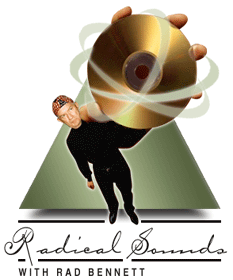 Someone recently asked me why I
don’t review CDs. What the four letters in SACD stand for is "Super Audio
Compact Disc." PentaTone, the record label based in the Netherlands that issues
recordings only on SACD, puts it this way: SA-CD, which might make the point more
clearly. When Sony began issuing SACDs, some of its titles contained only
advanced-resolution tracks, which meant they would not play at all in a regular CD player.
I haven’t seen one of those in a long time. Now, almost all SACDs released are
actually SACD/CDs, or hybrid discs, which contain a layer of standard CD audio in addition
to their high-resolution two-channel and/or multichannel tracks. And because these discs
are usually mastered with some care, the CD tracks sound good, too. But if you’re
devoted to CD’s "Red Book" 16-bit/44.1kHz standard, we’ve started a
new column, to rotate on a quarterly basis with "Radical Sounds" and
"Keepers." From what has trickled down to me from the recent Consumer
Electronics Show and the Internet, more changes in the priorities of formats are coming,
probably before the end of 2008, as CD and SACD give way to downloaded music files. Someone recently asked me why I
don’t review CDs. What the four letters in SACD stand for is "Super Audio
Compact Disc." PentaTone, the record label based in the Netherlands that issues
recordings only on SACD, puts it this way: SA-CD, which might make the point more
clearly. When Sony began issuing SACDs, some of its titles contained only
advanced-resolution tracks, which meant they would not play at all in a regular CD player.
I haven’t seen one of those in a long time. Now, almost all SACDs released are
actually SACD/CDs, or hybrid discs, which contain a layer of standard CD audio in addition
to their high-resolution two-channel and/or multichannel tracks. And because these discs
are usually mastered with some care, the CD tracks sound good, too. But if you’re
devoted to CD’s "Red Book" 16-bit/44.1kHz standard, we’ve started a
new column, to rotate on a quarterly basis with "Radical Sounds" and
"Keepers." From what has trickled down to me from the recent Consumer
Electronics Show and the Internet, more changes in the priorities of formats are coming,
probably before the end of 2008, as CD and SACD give way to downloaded music files.
Grainger: The Warriors; Irish Tune from County
Derry; Danish Folk-Music Suite; Hill-Songs 1 & 2; Beautiful
Fresh Flower; Colleen Dhas
Melbourne Symphony Orchestra; Geoffrey Simon, conductor.
Cala CADS 4033, Multichannel SACD/CD.
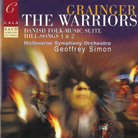 Percy Grainger (1882-1961) was born in
Melbourne, Australia, so it’s entirely appropriate that that city’s orchestra
record a program of his music. Grainger frequently used folk songs in his compositions,
and his music is complex -- he loved to experiment with sound, much in the manner of
Charles Ives. His music is as full of tremendous energy as was the man himself. I remember
when he came to the University of North Carolina to play the first movement of the Grieg
Piano Concerto and to conduct a few of his own works, and though then in his 70s, he
bounded on and off the stage like a crazed gazelle as he went back and forth to check
balances in the hall. The performances here are letter perfect and in the right spirit.
But this disc appears in this column is because of its sound. The recording was made in
1989 and has only now been remastered for multichannel SACD, but I had no idea it was that
old until I read the program notes. The sound is large and lush, with commanding bass, yet
the many exotic instruments in these scores -- vibraphone, harmonium, xylophone, gong,
and, in The Warriors, three pianos -- all come through with amazing clarity and
presence. The soundstage is deep, but the instruments playing at the back of it have
commanding presence. The two-channel tracks are quite acceptable, but don’t do
complete justice to Grainger’s intricate, colorful scoring. If you have multichannel
equipment, you’ll want to hear this disc many times over. Percy Grainger (1882-1961) was born in
Melbourne, Australia, so it’s entirely appropriate that that city’s orchestra
record a program of his music. Grainger frequently used folk songs in his compositions,
and his music is complex -- he loved to experiment with sound, much in the manner of
Charles Ives. His music is as full of tremendous energy as was the man himself. I remember
when he came to the University of North Carolina to play the first movement of the Grieg
Piano Concerto and to conduct a few of his own works, and though then in his 70s, he
bounded on and off the stage like a crazed gazelle as he went back and forth to check
balances in the hall. The performances here are letter perfect and in the right spirit.
But this disc appears in this column is because of its sound. The recording was made in
1989 and has only now been remastered for multichannel SACD, but I had no idea it was that
old until I read the program notes. The sound is large and lush, with commanding bass, yet
the many exotic instruments in these scores -- vibraphone, harmonium, xylophone, gong,
and, in The Warriors, three pianos -- all come through with amazing clarity and
presence. The soundstage is deep, but the instruments playing at the back of it have
commanding presence. The two-channel tracks are quite acceptable, but don’t do
complete justice to Grainger’s intricate, colorful scoring. If you have multichannel
equipment, you’ll want to hear this disc many times over.
Roy Harris: Symphonies 8 ("San Francisco") &
9; Memories of a Child’s Sunday
Alan Feinberg, piano; Albany Symphony Orchestra; David Alan Miller, conductor.
Albany TROY 350, Multichannel SACD.
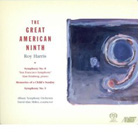 Roy Harris (1898-1979) is considered a
founder of the American school of symphonic composition. I once heard a discussion of
American music in which it was concluded that while American music comprises many
different elements, the main one held in common is that of energy. The word
certainly applies to these bustling works, with their skittering contrapuntal passages and
broad melodies punctuated by pungent rhythmic figures. Conductor David Alan Miller
understands this music inside out, and his Albany players respond to his direction with
clean, virtuoso playing. This recording did not start life as multichannel. It was
upsampled by Frederick Hohman at Zarex in a proprietary system that converts it to DSD.
Then, a six-channel mix was derived from the original master using the stereo phase
relationships to extract center, surround, and LFE tracks. If this disc is a typical
example of the results, the system works very well. The multichannel tracks have admirable
presence and are clean as the proverbial whistle. The recording was made in the fabled
Troy Savings Bank Music Hall in Troy, New York. It sounds like a fairly dry hall that
contributes little of its own ambience, making the music sound very transparent. The level
on the SACD is low; you’ll need to crank it up more than usual, but when you do, it
rocks. Roy Harris (1898-1979) is considered a
founder of the American school of symphonic composition. I once heard a discussion of
American music in which it was concluded that while American music comprises many
different elements, the main one held in common is that of energy. The word
certainly applies to these bustling works, with their skittering contrapuntal passages and
broad melodies punctuated by pungent rhythmic figures. Conductor David Alan Miller
understands this music inside out, and his Albany players respond to his direction with
clean, virtuoso playing. This recording did not start life as multichannel. It was
upsampled by Frederick Hohman at Zarex in a proprietary system that converts it to DSD.
Then, a six-channel mix was derived from the original master using the stereo phase
relationships to extract center, surround, and LFE tracks. If this disc is a typical
example of the results, the system works very well. The multichannel tracks have admirable
presence and are clean as the proverbial whistle. The recording was made in the fabled
Troy Savings Bank Music Hall in Troy, New York. It sounds like a fairly dry hall that
contributes little of its own ambience, making the music sound very transparent. The level
on the SACD is low; you’ll need to crank it up more than usual, but when you do, it
rocks.
Prokofiev: Symphony 5; Ode to the End of the
War
Russian National Orchestra; Vladimir Jurowski, conductor.
PentaTone 5186 083, Multichannel SACD/CD.
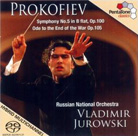 Prokofiev’s Fifth Symphony is
extraordinary music, but typical of the composer in its blend of lyric and rhythmic
elements. Conductor Vladimir Jurowski grasps all facets of the Russian composer’s
music, and the fine Russian National Orchestra responds to his direction splendidly. The
flittering rhythms of the second movement are mercurial in a Russian way, and the long
lines of the main melody in the third are lyrical to a fault. The strings sound rich and
play virtuosically; the brass can be mellow, yet snarl when asked to do so. It all adds up
to a five-star recording of this work, and the recording helps. It’s spacious yet
detailed, with good stereo separation up front and just the right amount of rear ambience.
One easily perceives the stage depth: the woodwinds are center and back a little, the
brass and percussion behind them, yet all have equal presence. The Symphony 5 was recorded
in concert, with patches inserted later to replace passages marred by applause. The
recording of the Ode to the End of the War (referring to World War II) was made
without audience, and does a great job of conveying Prokofiev’s exotic scoring for
wind band, eight double basses, eight harps, four pianos, and percussion. The percussion
have a field day, the engineers accurately documenting every solid thud of bass
drum, every shimmer of struck cymbal, every entrance of the deliberately intrusive snare.
It is, in short an ideal recording that I don’t think anything could improve. Prokofiev’s Fifth Symphony is
extraordinary music, but typical of the composer in its blend of lyric and rhythmic
elements. Conductor Vladimir Jurowski grasps all facets of the Russian composer’s
music, and the fine Russian National Orchestra responds to his direction splendidly. The
flittering rhythms of the second movement are mercurial in a Russian way, and the long
lines of the main melody in the third are lyrical to a fault. The strings sound rich and
play virtuosically; the brass can be mellow, yet snarl when asked to do so. It all adds up
to a five-star recording of this work, and the recording helps. It’s spacious yet
detailed, with good stereo separation up front and just the right amount of rear ambience.
One easily perceives the stage depth: the woodwinds are center and back a little, the
brass and percussion behind them, yet all have equal presence. The Symphony 5 was recorded
in concert, with patches inserted later to replace passages marred by applause. The
recording of the Ode to the End of the War (referring to World War II) was made
without audience, and does a great job of conveying Prokofiev’s exotic scoring for
wind band, eight double basses, eight harps, four pianos, and percussion. The percussion
have a field day, the engineers accurately documenting every solid thud of bass
drum, every shimmer of struck cymbal, every entrance of the deliberately intrusive snare.
It is, in short an ideal recording that I don’t think anything could improve.
Howard Shore: The Lord of the Rings: The Return of
the King -- The Complete Recordings
Renée Fleming, Sir James Galway, Ben del Maestro, Annie Lenox, Sissel, Liv Tyler, Billy
Boyd, Dominic Monaghan; London Philharmonic Orchestra; Howard Shore, conductor.
Reprise 162044-2, 4 CDs, 1 DVD-Audio. Mixes: Dolby Digital 5.1 and 2.0 mixes, MLP 5.1 and
2.0 mixes.
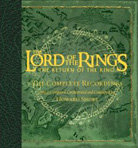 This is the third and final installment
in Reprise’s recordings of the complete music from The Lord of the Rings
films. The only other film project of similar scope is the music for the six Star Wars
films, all composed by John Williams. Because so much music was composed for each Rings
film, it has taken three CDs and one DVD-Audio disc to contain the music of each of the
first two chapters of the trilogy, and now, for The Return of the King, no fewer
than four CDs and a double-sided DVD-A. This last volume is laid out like the
others: The CDs are contained in a four-disc foldout inside a box of leatherette. As in
the preceding sets, the DVD-A perches, not all that securely, on a hub on the inside of
the box lid. The DVD-A contains all the music found on the CDs, but in glorious
5.1-channel MLP sound. Whether solo flute or full orchestra with chorus, the sound is
magnificent, with excellent definition and focus. The bass is singularly well focused in
addition to being ample, and the surround channels add great warmth without calling
attention to themselves. The percussion instruments have great bite without ever sounding
shrill or distorted -- quite an accomplishment. This set makes me wish that all big
orchestral soundtracks were released in hi-rez surround sound. The Star Wars
soundtracks, in particular, seem to cry out for such deluxe treatment. This is the third and final installment
in Reprise’s recordings of the complete music from The Lord of the Rings
films. The only other film project of similar scope is the music for the six Star Wars
films, all composed by John Williams. Because so much music was composed for each Rings
film, it has taken three CDs and one DVD-Audio disc to contain the music of each of the
first two chapters of the trilogy, and now, for The Return of the King, no fewer
than four CDs and a double-sided DVD-A. This last volume is laid out like the
others: The CDs are contained in a four-disc foldout inside a box of leatherette. As in
the preceding sets, the DVD-A perches, not all that securely, on a hub on the inside of
the box lid. The DVD-A contains all the music found on the CDs, but in glorious
5.1-channel MLP sound. Whether solo flute or full orchestra with chorus, the sound is
magnificent, with excellent definition and focus. The bass is singularly well focused in
addition to being ample, and the surround channels add great warmth without calling
attention to themselves. The percussion instruments have great bite without ever sounding
shrill or distorted -- quite an accomplishment. This set makes me wish that all big
orchestral soundtracks were released in hi-rez surround sound. The Star Wars
soundtracks, in particular, seem to cry out for such deluxe treatment.
Haydn: Symphonies 97 & 102; Overture
"L’anima del filosofo ossia Orfeo ed Euridice"
Austro-Hungarian Haydn Philharmonic; Adám Fischer, conductor.
MDG 901 1452, Multichannel SACD/CD.
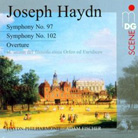 Let’s hope that this, conductor
Adám Fischer’s second Haydn release on MDG, means that there will be an ongoing
series of the symphonies. This time Fischer has chosen two of the composer’s happiest
symphonies, both in major keys, and his performances bubble over with good humor. The prestos
are exceptionally fleet, at tempos that would find some orchestras scrambling for notes.
But in the hands of the Austro-Hungarian Haydn Philharmonic everything remains precise, no
matter the speed -- this is some of the cleanest playing I have heard from an orchestra.
The recording is exceptionally clean, too, with good stage width and depth and remarkable
dynamic range. Take the Menuetto of Symphony 97: The strings echo the first
statement of the theme note for note, but pianissimo. The woodwinds play their
solos and duets from a space clearly tucked in slightly behind the strings; the brass and
timpani (with their surprising early entrance) interject from a space a little farther
back. All instruments have good presence. The two-channel tracks are crisp and clean; the
multichannel ones add just a little ambience in the rear channels to make the sound up
front more three-dimensional. The vivacious overture is a neat bonus. This disc is a
winner all the way. Let’s hope that this, conductor
Adám Fischer’s second Haydn release on MDG, means that there will be an ongoing
series of the symphonies. This time Fischer has chosen two of the composer’s happiest
symphonies, both in major keys, and his performances bubble over with good humor. The prestos
are exceptionally fleet, at tempos that would find some orchestras scrambling for notes.
But in the hands of the Austro-Hungarian Haydn Philharmonic everything remains precise, no
matter the speed -- this is some of the cleanest playing I have heard from an orchestra.
The recording is exceptionally clean, too, with good stage width and depth and remarkable
dynamic range. Take the Menuetto of Symphony 97: The strings echo the first
statement of the theme note for note, but pianissimo. The woodwinds play their
solos and duets from a space clearly tucked in slightly behind the strings; the brass and
timpani (with their surprising early entrance) interject from a space a little farther
back. All instruments have good presence. The two-channel tracks are crisp and clean; the
multichannel ones add just a little ambience in the rear channels to make the sound up
front more three-dimensional. The vivacious overture is a neat bonus. This disc is a
winner all the way.
Britannia
Britten: Sinfonia da Requiem
Davies: An Orkney Wedding, with Sunrise
Elgar: Pomp and Circumstance Marches 1 & 4
MacMillan: Britannia
Turnage: Three Screaming Popes
Atlanta Symphony Orchestra; Donald Runnicles, conductor.
Telarc SACD-60677, Multichannel SACD/CD.
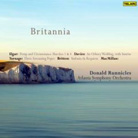 The Atlanta Symphony Orchestra is very
fortunate to have Donald Runnicles as principal guest conductor. For my money, he often
turns in the best performances, outshining even those of music director Robert Spano.
Telarc seems aware of this, as they have divided their recordings of the orchestra about
equally between the two young maestros. In this collection, Runnicles offers an
exceptionally varied menu of British compositions, ranging from two of Elgar’s noble Pomp
and Circumstance marches to the strident Three Screaming Popes by
Mark-Anthony Turnage. Benjamin Britten’s Sinfonia da Requiem, perhaps the
best-known work after the Elgar, is given a taut, dramatic reading that is among the best
on disc. As usual, the Telarc production team has come up with sound that is just right,
with a stage depth that is particularly impressive. James MacMillan’s Britannia
is a singularly complex work scored for a wide variety of percussion instruments,
including car horns and referees’ whistles. The engineers have handled them with
accuracy and ease. In fact, if you want to hear how important transparency can be to a
great recording, the MacMillan offers ample opportunity for the engineering to shine
alongside the virtuoso playing. The Atlanta Symphony Orchestra is very
fortunate to have Donald Runnicles as principal guest conductor. For my money, he often
turns in the best performances, outshining even those of music director Robert Spano.
Telarc seems aware of this, as they have divided their recordings of the orchestra about
equally between the two young maestros. In this collection, Runnicles offers an
exceptionally varied menu of British compositions, ranging from two of Elgar’s noble Pomp
and Circumstance marches to the strident Three Screaming Popes by
Mark-Anthony Turnage. Benjamin Britten’s Sinfonia da Requiem, perhaps the
best-known work after the Elgar, is given a taut, dramatic reading that is among the best
on disc. As usual, the Telarc production team has come up with sound that is just right,
with a stage depth that is particularly impressive. James MacMillan’s Britannia
is a singularly complex work scored for a wide variety of percussion instruments,
including car horns and referees’ whistles. The engineers have handled them with
accuracy and ease. In fact, if you want to hear how important transparency can be to a
great recording, the MacMillan offers ample opportunity for the engineering to shine
alongside the virtuoso playing.
...Rad Bennett
radb@ultraaudio.com

All contents copyright Schneider Publishing Inc., all rights
reserved.
Any reproduction, without permission, is prohibited.
Ultra Audio is part of the SoundStage! Network.
A world of websites and publications for audio, video, music, and movie enthusiasts. |

 Someone recently asked me why I
don’t review CDs. What the four letters in SACD stand for is "Super Audio
Compact Disc." PentaTone, the record label based in the Netherlands that issues
recordings only on SACD, puts it this way: SA-CD, which might make the point more
clearly. When Sony began issuing SACDs, some of its titles contained only
advanced-resolution tracks, which meant they would not play at all in a regular CD player.
I haven’t seen one of those in a long time. Now, almost all SACDs released are
actually SACD/CDs, or hybrid discs, which contain a layer of standard CD audio in addition
to their high-resolution two-channel and/or multichannel tracks. And because these discs
are usually mastered with some care, the CD tracks sound good, too. But if you’re
devoted to CD’s "Red Book" 16-bit/44.1kHz standard, we’ve started a
new column, to rotate on a quarterly basis with "Radical Sounds" and
"Keepers." From what has trickled down to me from the recent Consumer
Electronics Show and the Internet, more changes in the priorities of formats are coming,
probably before the end of 2008, as CD and SACD give way to downloaded music files.
Someone recently asked me why I
don’t review CDs. What the four letters in SACD stand for is "Super Audio
Compact Disc." PentaTone, the record label based in the Netherlands that issues
recordings only on SACD, puts it this way: SA-CD, which might make the point more
clearly. When Sony began issuing SACDs, some of its titles contained only
advanced-resolution tracks, which meant they would not play at all in a regular CD player.
I haven’t seen one of those in a long time. Now, almost all SACDs released are
actually SACD/CDs, or hybrid discs, which contain a layer of standard CD audio in addition
to their high-resolution two-channel and/or multichannel tracks. And because these discs
are usually mastered with some care, the CD tracks sound good, too. But if you’re
devoted to CD’s "Red Book" 16-bit/44.1kHz standard, we’ve started a
new column, to rotate on a quarterly basis with "Radical Sounds" and
"Keepers." From what has trickled down to me from the recent Consumer
Electronics Show and the Internet, more changes in the priorities of formats are coming,
probably before the end of 2008, as CD and SACD give way to downloaded music files.  Percy Grainger (1882-1961) was born in
Melbourne, Australia, so it’s entirely appropriate that that city’s orchestra
record a program of his music. Grainger frequently used folk songs in his compositions,
and his music is complex -- he loved to experiment with sound, much in the manner of
Charles Ives. His music is as full of tremendous energy as was the man himself. I remember
when he came to the University of North Carolina to play the first movement of the Grieg
Piano Concerto and to conduct a few of his own works, and though then in his 70s, he
bounded on and off the stage like a crazed gazelle as he went back and forth to check
balances in the hall. The performances here are letter perfect and in the right spirit.
But this disc appears in this column is because of its sound. The recording was made in
1989 and has only now been remastered for multichannel SACD, but I had no idea it was that
old until I read the program notes. The sound is large and lush, with commanding bass, yet
the many exotic instruments in these scores -- vibraphone, harmonium, xylophone, gong,
and, in The Warriors, three pianos -- all come through with amazing clarity and
presence. The soundstage is deep, but the instruments playing at the back of it have
commanding presence. The two-channel tracks are quite acceptable, but don’t do
complete justice to Grainger’s intricate, colorful scoring. If you have multichannel
equipment, you’ll want to hear this disc many times over.
Percy Grainger (1882-1961) was born in
Melbourne, Australia, so it’s entirely appropriate that that city’s orchestra
record a program of his music. Grainger frequently used folk songs in his compositions,
and his music is complex -- he loved to experiment with sound, much in the manner of
Charles Ives. His music is as full of tremendous energy as was the man himself. I remember
when he came to the University of North Carolina to play the first movement of the Grieg
Piano Concerto and to conduct a few of his own works, and though then in his 70s, he
bounded on and off the stage like a crazed gazelle as he went back and forth to check
balances in the hall. The performances here are letter perfect and in the right spirit.
But this disc appears in this column is because of its sound. The recording was made in
1989 and has only now been remastered for multichannel SACD, but I had no idea it was that
old until I read the program notes. The sound is large and lush, with commanding bass, yet
the many exotic instruments in these scores -- vibraphone, harmonium, xylophone, gong,
and, in The Warriors, three pianos -- all come through with amazing clarity and
presence. The soundstage is deep, but the instruments playing at the back of it have
commanding presence. The two-channel tracks are quite acceptable, but don’t do
complete justice to Grainger’s intricate, colorful scoring. If you have multichannel
equipment, you’ll want to hear this disc many times over. Roy Harris (1898-1979) is considered a
founder of the American school of symphonic composition. I once heard a discussion of
American music in which it was concluded that while American music comprises many
different elements, the main one held in common is that of energy. The word
certainly applies to these bustling works, with their skittering contrapuntal passages and
broad melodies punctuated by pungent rhythmic figures. Conductor David Alan Miller
understands this music inside out, and his Albany players respond to his direction with
clean, virtuoso playing. This recording did not start life as multichannel. It was
upsampled by Frederick Hohman at Zarex in a proprietary system that converts it to DSD.
Then, a six-channel mix was derived from the original master using the stereo phase
relationships to extract center, surround, and LFE tracks. If this disc is a typical
example of the results, the system works very well. The multichannel tracks have admirable
presence and are clean as the proverbial whistle. The recording was made in the fabled
Troy Savings Bank Music Hall in Troy, New York. It sounds like a fairly dry hall that
contributes little of its own ambience, making the music sound very transparent. The level
on the SACD is low; you’ll need to crank it up more than usual, but when you do, it
rocks.
Roy Harris (1898-1979) is considered a
founder of the American school of symphonic composition. I once heard a discussion of
American music in which it was concluded that while American music comprises many
different elements, the main one held in common is that of energy. The word
certainly applies to these bustling works, with their skittering contrapuntal passages and
broad melodies punctuated by pungent rhythmic figures. Conductor David Alan Miller
understands this music inside out, and his Albany players respond to his direction with
clean, virtuoso playing. This recording did not start life as multichannel. It was
upsampled by Frederick Hohman at Zarex in a proprietary system that converts it to DSD.
Then, a six-channel mix was derived from the original master using the stereo phase
relationships to extract center, surround, and LFE tracks. If this disc is a typical
example of the results, the system works very well. The multichannel tracks have admirable
presence and are clean as the proverbial whistle. The recording was made in the fabled
Troy Savings Bank Music Hall in Troy, New York. It sounds like a fairly dry hall that
contributes little of its own ambience, making the music sound very transparent. The level
on the SACD is low; you’ll need to crank it up more than usual, but when you do, it
rocks. Prokofiev’s Fifth Symphony is
extraordinary music, but typical of the composer in its blend of lyric and rhythmic
elements. Conductor Vladimir Jurowski grasps all facets of the Russian composer’s
music, and the fine Russian National Orchestra responds to his direction splendidly. The
flittering rhythms of the second movement are mercurial in a Russian way, and the long
lines of the main melody in the third are lyrical to a fault. The strings sound rich and
play virtuosically; the brass can be mellow, yet snarl when asked to do so. It all adds up
to a five-star recording of this work, and the recording helps. It’s spacious yet
detailed, with good stereo separation up front and just the right amount of rear ambience.
One easily perceives the stage depth: the woodwinds are center and back a little, the
brass and percussion behind them, yet all have equal presence. The Symphony 5 was recorded
in concert, with patches inserted later to replace passages marred by applause. The
recording of the Ode to the End of the War (referring to World War II) was made
without audience, and does a great job of conveying Prokofiev’s exotic scoring for
wind band, eight double basses, eight harps, four pianos, and percussion. The percussion
have a field day, the engineers accurately documenting every solid thud of bass
drum, every shimmer of struck cymbal, every entrance of the deliberately intrusive snare.
It is, in short an ideal recording that I don’t think anything could improve.
Prokofiev’s Fifth Symphony is
extraordinary music, but typical of the composer in its blend of lyric and rhythmic
elements. Conductor Vladimir Jurowski grasps all facets of the Russian composer’s
music, and the fine Russian National Orchestra responds to his direction splendidly. The
flittering rhythms of the second movement are mercurial in a Russian way, and the long
lines of the main melody in the third are lyrical to a fault. The strings sound rich and
play virtuosically; the brass can be mellow, yet snarl when asked to do so. It all adds up
to a five-star recording of this work, and the recording helps. It’s spacious yet
detailed, with good stereo separation up front and just the right amount of rear ambience.
One easily perceives the stage depth: the woodwinds are center and back a little, the
brass and percussion behind them, yet all have equal presence. The Symphony 5 was recorded
in concert, with patches inserted later to replace passages marred by applause. The
recording of the Ode to the End of the War (referring to World War II) was made
without audience, and does a great job of conveying Prokofiev’s exotic scoring for
wind band, eight double basses, eight harps, four pianos, and percussion. The percussion
have a field day, the engineers accurately documenting every solid thud of bass
drum, every shimmer of struck cymbal, every entrance of the deliberately intrusive snare.
It is, in short an ideal recording that I don’t think anything could improve. This is the third and final installment
in Reprise’s recordings of the complete music from The Lord of the Rings
films. The only other film project of similar scope is the music for the six Star Wars
films, all composed by John Williams. Because so much music was composed for each Rings
film, it has taken three CDs and one DVD-Audio disc to contain the music of each of the
first two chapters of the trilogy, and now, for The Return of the King, no fewer
than four CDs and a double-sided DVD-A. This last volume is laid out like the
others: The CDs are contained in a four-disc foldout inside a box of leatherette. As in
the preceding sets, the DVD-A perches, not all that securely, on a hub on the inside of
the box lid. The DVD-A contains all the music found on the CDs, but in glorious
5.1-channel MLP sound. Whether solo flute or full orchestra with chorus, the sound is
magnificent, with excellent definition and focus. The bass is singularly well focused in
addition to being ample, and the surround channels add great warmth without calling
attention to themselves. The percussion instruments have great bite without ever sounding
shrill or distorted -- quite an accomplishment. This set makes me wish that all big
orchestral soundtracks were released in hi-rez surround sound. The Star Wars
soundtracks, in particular, seem to cry out for such deluxe treatment.
This is the third and final installment
in Reprise’s recordings of the complete music from The Lord of the Rings
films. The only other film project of similar scope is the music for the six Star Wars
films, all composed by John Williams. Because so much music was composed for each Rings
film, it has taken three CDs and one DVD-Audio disc to contain the music of each of the
first two chapters of the trilogy, and now, for The Return of the King, no fewer
than four CDs and a double-sided DVD-A. This last volume is laid out like the
others: The CDs are contained in a four-disc foldout inside a box of leatherette. As in
the preceding sets, the DVD-A perches, not all that securely, on a hub on the inside of
the box lid. The DVD-A contains all the music found on the CDs, but in glorious
5.1-channel MLP sound. Whether solo flute or full orchestra with chorus, the sound is
magnificent, with excellent definition and focus. The bass is singularly well focused in
addition to being ample, and the surround channels add great warmth without calling
attention to themselves. The percussion instruments have great bite without ever sounding
shrill or distorted -- quite an accomplishment. This set makes me wish that all big
orchestral soundtracks were released in hi-rez surround sound. The Star Wars
soundtracks, in particular, seem to cry out for such deluxe treatment. Let’s hope that this, conductor
Adám Fischer’s second Haydn release on MDG, means that there will be an ongoing
series of the symphonies. This time Fischer has chosen two of the composer’s happiest
symphonies, both in major keys, and his performances bubble over with good humor. The prestos
are exceptionally fleet, at tempos that would find some orchestras scrambling for notes.
But in the hands of the Austro-Hungarian Haydn Philharmonic everything remains precise, no
matter the speed -- this is some of the cleanest playing I have heard from an orchestra.
The recording is exceptionally clean, too, with good stage width and depth and remarkable
dynamic range. Take the Menuetto of Symphony 97: The strings echo the first
statement of the theme note for note, but pianissimo. The woodwinds play their
solos and duets from a space clearly tucked in slightly behind the strings; the brass and
timpani (with their surprising early entrance) interject from a space a little farther
back. All instruments have good presence. The two-channel tracks are crisp and clean; the
multichannel ones add just a little ambience in the rear channels to make the sound up
front more three-dimensional. The vivacious overture is a neat bonus. This disc is a
winner all the way.
Let’s hope that this, conductor
Adám Fischer’s second Haydn release on MDG, means that there will be an ongoing
series of the symphonies. This time Fischer has chosen two of the composer’s happiest
symphonies, both in major keys, and his performances bubble over with good humor. The prestos
are exceptionally fleet, at tempos that would find some orchestras scrambling for notes.
But in the hands of the Austro-Hungarian Haydn Philharmonic everything remains precise, no
matter the speed -- this is some of the cleanest playing I have heard from an orchestra.
The recording is exceptionally clean, too, with good stage width and depth and remarkable
dynamic range. Take the Menuetto of Symphony 97: The strings echo the first
statement of the theme note for note, but pianissimo. The woodwinds play their
solos and duets from a space clearly tucked in slightly behind the strings; the brass and
timpani (with their surprising early entrance) interject from a space a little farther
back. All instruments have good presence. The two-channel tracks are crisp and clean; the
multichannel ones add just a little ambience in the rear channels to make the sound up
front more three-dimensional. The vivacious overture is a neat bonus. This disc is a
winner all the way. The Atlanta Symphony Orchestra is very
fortunate to have Donald Runnicles as principal guest conductor. For my money, he often
turns in the best performances, outshining even those of music director Robert Spano.
Telarc seems aware of this, as they have divided their recordings of the orchestra about
equally between the two young maestros. In this collection, Runnicles offers an
exceptionally varied menu of British compositions, ranging from two of Elgar’s noble Pomp
and Circumstance marches to the strident Three Screaming Popes by
Mark-Anthony Turnage. Benjamin Britten’s Sinfonia da Requiem, perhaps the
best-known work after the Elgar, is given a taut, dramatic reading that is among the best
on disc. As usual, the Telarc production team has come up with sound that is just right,
with a stage depth that is particularly impressive. James MacMillan’s Britannia
is a singularly complex work scored for a wide variety of percussion instruments,
including car horns and referees’ whistles. The engineers have handled them with
accuracy and ease. In fact, if you want to hear how important transparency can be to a
great recording, the MacMillan offers ample opportunity for the engineering to shine
alongside the virtuoso playing.
The Atlanta Symphony Orchestra is very
fortunate to have Donald Runnicles as principal guest conductor. For my money, he often
turns in the best performances, outshining even those of music director Robert Spano.
Telarc seems aware of this, as they have divided their recordings of the orchestra about
equally between the two young maestros. In this collection, Runnicles offers an
exceptionally varied menu of British compositions, ranging from two of Elgar’s noble Pomp
and Circumstance marches to the strident Three Screaming Popes by
Mark-Anthony Turnage. Benjamin Britten’s Sinfonia da Requiem, perhaps the
best-known work after the Elgar, is given a taut, dramatic reading that is among the best
on disc. As usual, the Telarc production team has come up with sound that is just right,
with a stage depth that is particularly impressive. James MacMillan’s Britannia
is a singularly complex work scored for a wide variety of percussion instruments,
including car horns and referees’ whistles. The engineers have handled them with
accuracy and ease. In fact, if you want to hear how important transparency can be to a
great recording, the MacMillan offers ample opportunity for the engineering to shine
alongside the virtuoso playing.